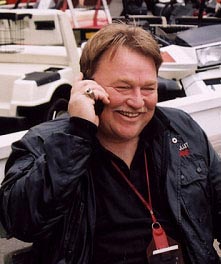
A simple solution to
I was watching the NHRA World Finals from the fabled Pomona Fairgrounds on TV, ensconced in the ol' Burk-a-lounger. Despite the fact that most of the World Championships were sewed up prior to the event, it still promised to be a hell of a race. Then I watched with disbelief as almost every Top Fuel and Funny Car running in the right lane smoked the tires and lost. It wasn't just a few lower tier competitors gambling on a tune-up trying to beat a team they shouldn't. It was almost every car that staged in that lane. I think at one point only two of 15 cars forced to race down that traction-less right lane managed to get to the other end under full power and win. I'm not positive of that number but believe me it was bad racing and bad entertainment. As I was watching this fiasco unfold in front of me I muttered out loud at my TV as if the NHRA officials could hear me, "This isn't live TV! Why don't you stop the race for a half hour or so and at least try to fix that lane?" I wondered, if most of the professional World Championships hadn't already been decided, would Rick Stewart or Graham Light have stopped the proceedings and attempted to repair that lane. What if someone had lost a World Championship because NHRA couldn't be bothered to give the racers the famous "level playing field" they often refer to? I had to sympathize with a justifiably upset Whit Bazemore when he returned to the starting line with a few choice words for starter Rick Stewart. Evidently they were real choice words because they contributed to Whit receiving a record $15,000 fine and two-year probation from the high sheriffs. Too bad Whit was the only driver with the gumption to tell Mr. Stewart what everyone else was thinking. But I digress. For some time sanctioning bodies have been seeking a solution for the ongoing problem the sport faces of trying to control the spiraling cost of racing in the professional classes, speeds of the Fuel cars, equaling the competition between alky and injected-nitro cars in NHRA and blown vs. nitrous cars in the IHRA, and, perhaps most importantly, the non-racing that comes when we have one-lane tracks on race day. So far, the best solution to these problems the sanctioning bodies have been able to come up with are rule changes that cost the racers a ton of money and tech officials their sanity. And they just haven't worked so far. I offer as examples Top Fuel, Funny Car, Pro Stock, Pro Mod and Pro Stock Bike. Despite the sanctioning bodies' best efforts, all of the Pro classes just keep getting quicker and faster -- you can look it up. So here is my simple three-part solution which I don't think will cost the racers or the sanctioning bodies a lot of money and should be easy to implement and manage. First, throw in the towel and make traction control legal in all Sportsman classes. Traction control is here to stay in the Sportsman classes and on any car that has EFI. Both NHRA and IHRA have as much as admitted they can't police it, so just make the use of it legal and be done with it. Almost every racer and engine builder I've talked to says that traction control will go a long way toward reducing the number of engine failures and will cut expenses. Second, quit spending enormous amounts of time and money trying to make track surfaces with perfect traction co-efficient. It is impossible to do, especially over a three or four day period. I'm not kidding. Instead of spending all that time, money and effort trying to achieve a two-lane race track so that everyone from the lowest class of bracket racer to the fuel cars won't spin a tire no matter how much power they try to apply to the surface, do just the opposite. Keep the entire track from the water box to the stripe as clean and smooth as possible, but cut way back on the traction compound, dragging rubber tires, constant spraying and scraping. Imagine the savings in down time during the race if all that was required to clean up an oil-down and return the track and traction to normal was to run a street cleaner over it. Since a majority of the Sportsman racers at national events run on an Index, why do they need a track that will pull your shoes off at 1,000 feet? All any of those racers really want is a track that is consistent. If they have traction control it won't make any difference how slick it is on the starting line or down track. They'll have traction control to compensate. If a majority of us agree that many of the top professional class cars are too fast for the tracks to hold -- and by all indications that's what they believe at both NHRA and IHRA -- why then are those sanctioning bodies spending so much effort to give them tracks with the kind of traction that will deliver 4.40/335 laps for Top Fuel cars, 4.60/335 laps from Fuel Coupes and sub-six second laps from Pro Mods when the atmospheric conditions allow? I say keep all of the current tire rules, engine rules, aero rules and whatever else has been developed to slow the faster classes down and make them safer. Freeze the rules where they are! I believe this is an idea that can work. I know of a regional Pro Mod circuit where a majority of the teams are "budget" racers who don't have the parts and money to compete with "Professional" Pro Mod racers. The circuit's prize money was good enough that occasionally a "Pro" would show up at one of their events. The first time it happened the Pro was so much quicker than the regular racers that the circuit organizers decided to try and "level" the playing field. Their solution was both simple and effective. They instructed the track crew to not groom the track other than running the sweeper over it, cleaning up any oil-downs. The result was the "budget" racers and the touring Pros had to run on a somewhat slick track and the faster Pros had to dial some power out of their engines. Nobody complained, more racers were competitive, and there seemed to be fewer oil-downs. It was evident to me that a track that won't take all the horsepower a tuner can throw at it makes the racing much less a contest between who has the most money and horsepower and more of a contest between the best driver and tuner. I think one thing everyone will agree on is that there have been far too many one-lane tracks at both IHRA and NHRA National events, and the sport desperately needs a solution for both the racers and fans. Home viewers can't smell the nitro, hear the sound, or feel the visceral experience fans at the track do. Since the TV crews producing the coverage of drag racing seem unable to convey that experience to the audience at home, drag racing better find a way to deliver competitive racing all day on Sunday. I'm sure someone will write me with some very good reasons why my
idea is worthless and stupid. Fine, give me a better one because
right now on Sunday during eliminations what we are seeing as fans
(whether we're sitting in the stands or reclining in front of the
tube) isn't entertaining racing and I'm of the opinion that's at
least part of the reason for the constant drop in TV ratings for
traditional drag racing, while reality shows involving drag racing
thrive in the ratings. |
|||||||||||||||||||||||||||||||||||||||||||||




